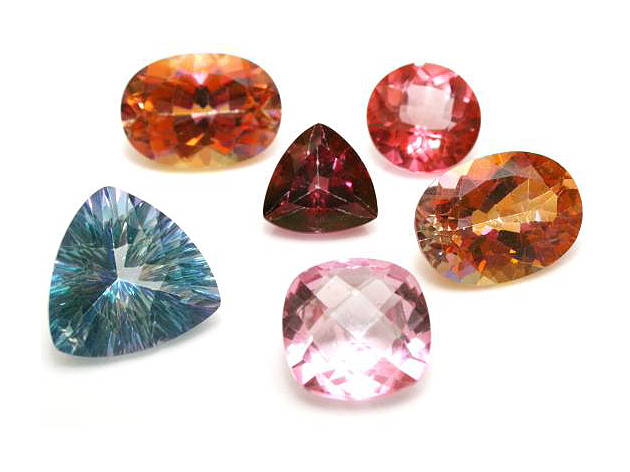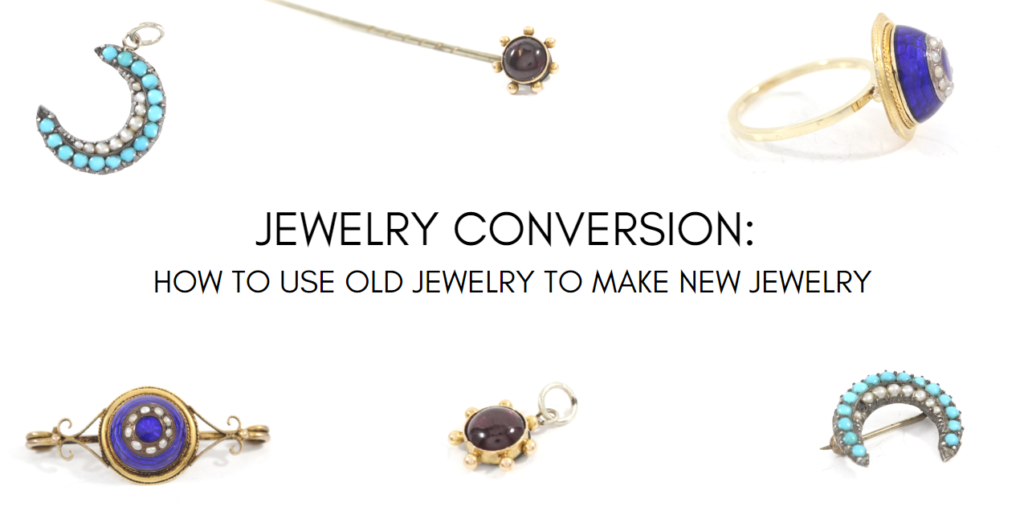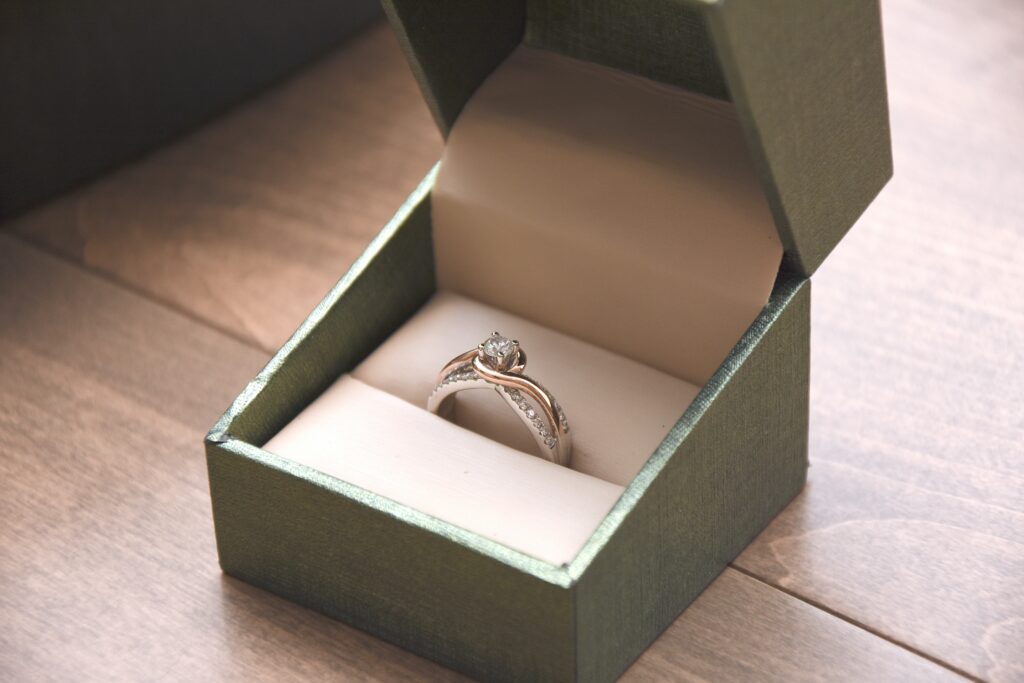How to Buy Loose Stones Yourself
Written by Annabelle
April 20, 2020

If you’ve always prided yourself on being a DIY person with an eye for detail, chances are you’ve thought about modifying your jewelry or creating your own jewelry with a unique stone. But in this confusing, hard-to-navigate world of jewelry, how do you get your hands on loose gemstones and diamonds? Here’s how to buy loose stones.
3 Steps On How to Buy Loose Stones
1. Determine What You Want
The world of gemstones is filled with a dazzling variety of jewels to choose from! To narrow down what you want, we’ve listed several criteria below.

Even within one color there are a lot of gems to choose from. From left to right: aquamarine, sapphire, blue topaz.
- Color: The most important thing to first determine is what color you want! Several different stone types can come in the same color, so if you want something purple you can choose from amethyst, charoite, fluorite, sapphire, spinel, and even diamond! Of course, not all stones are the same even if they share the same color; for example, a purple sapphire is generally transparent, while a charoite stone is opaque with patterns.
- Durability: Not all stones are equally hard- gemstones are rated on the Mohs scale in terms of durability. Diamonds rank at the top, and other stones fall behind accordingly. If you’re looking for something hard-wearing, it’d be best to choose a more durable stone for your new gem.
- Shape & Cut: Do you prefer round stones? Perhaps you’d like a custom shape, like a shield or a star. Give this some thought, as a stone can be bought and recut if necessary. The cutting will also affect its pricing; as an example, diamonds are graded by how precisely they’re cut to display the stone’s brilliance. The better the cut grade, the more expensive the diamond.
- Size: It goes without saying that carat size is important. Keep in mind that the larger the stone, the more difficult it is to procure (especially if the stone is rare.) The price will also go up considerably.
- Type: Finally, once you’ve fleshed out all of your criteria, it’s important to select what type of stone you’re looking to buy. If you want a green, asscher-cut gemstone and you’re not too concerned about durability, chances are you’re looking for an emerald.
2. Do Your Research
Now that you’ve figured out what loose stone you want, it’s important to understand that you’re getting a credible buy. This is important because there are unfortunately a lot of frauds in this business, especially from overseas vendors. Here are a few things to look for:
- Research the stone thoroughly: One of the worst scams we saw was from an unfortunate client who brought in a “23 carat pink zircon” he had purchased online. Upon closer inspection it turned out to be a cubic zirconia that was coated with a pink chemical. If the price is too good to be true for a stone that you know is incredibly rare- chances are, that’s a scam.
- Phony certifications: In the case of our poor zircon-loving friend, he was sold on the stone because it was promised as “certified.” The certification made no mention of a certified gemologist and in fact had typos all over it. When purchasing a certified stone, it’s best if the stone is GIA-certified with the Gemological Institute of America. This institution is world-renowned and the certification is issued by their in-house gemologists. In addition, it receives a specific certification number that is kept in their report database, allowing you to confirm the validity of the certification.

A 3D design for a ring we created, with a GIA-certified diamond.
- Poorly treated low-grade items: Stones range from untreated to slight treatment (which is typical of most commercial gems and is considered an acceptable practice.) However, some cheap stones from overseas countries such as Afghanistan or India are heavily dyed and injected with fillers such as glass to hide fractures and other blemishes in the stone. Not only may you be paying extra for these poor-quality stones, but you risk the possibility of the stone breaking apart at some point if exposed to heat or any kind of jewelry repair work. To avoid this from happening, it’s important to purchase from a reputable vendor.
3. Find a Reputable Vendor
The final step is to find a place where you can buy loose stones! For diamonds, this is fairly easy- checking sites such as James Allen and Blue Nile are standard and will yield high quality results with excellent credentials. For colored gemstones, however, the process is a bit murky, especially if you're looking for an atypical stone. Here are a few places you can get started:
- Etsy & Ebay: If you’re interested in browsing for a stone, there’s no better way to check it out than to search on Etsy and Ebay. Etsy is slightly better in terms of quality as many gemstone suppliers sell to craftsmen and designers on there, and reviews tend to be more credible. In addition, GIA-certified gemologists often run their own shops on Etsy, so you’re more likely to find GIA-certified or appraised stones on there.
Ebay is a hit or miss; while it provides a wide variety of vendors many of them are from overseas. That being said, you are more likely to find certain rare stones on Ebay as it has a broader range of products available. It’s best to be cautious and check all details before purchasing. - Independent Gem Vendors: Independent gem sellers will have their own sites set up; a quick Google search and you’ll be able to find them. Prices are all over the place for these vendors, but they may be more worthwhile to check out than Etsy and Ebay if you’re looking for region-specific gemstones. As an example, Montana sapphires are highly popular and many vendors will sell independently off e-commerce sites.
- Jewelry Repair Companies: Not to toot our own horn, but some jewelry repair companies (like us) can navigate the murky depths of stone sourcing for you with our in-house lapidary. With ties to vendors both locally and overseas, jewelers are a straightforward option to consider because you can get the stone certified, recut, and set all in one go.
Now you’re all set on how to buy loose stones! Whether it’s a special colored diamond or a sparkly synthetic gem, find the jewel that’s just right for your needs today. Comment below if you’d like to get started on the process!



Thank you very much. I am about to embark on the challenge of making my own engagement ring. Naturally a stone is critical in this venture and you have given me lots of info to get started.
Thanks again
Shawn